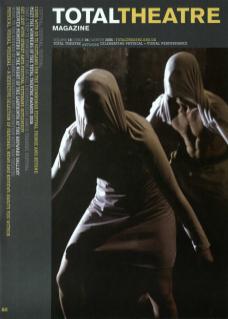The Magic Bus was a talking point at this year’s Fringe: an innovative venue cum programming initiative that took ‘live art, wonder and weirdness’ to Edinburgh, with performances sited in and around a Routemaster bus parked in The Meadows.
Treats on offer included Miss High Leg Kick’s Fashion Bus, in which Miss Kick, initially clad in clippie garb (hot pants, fishnets, cute cap and a resolutely non-digital ticket machine), together with a roster of accomplices (Dorian Gray, Boogaloo Stu, Miss Knickers et al) presented a parade of fashion victims as witnessed on London routes from Peckham to Piccadilly, Bank to New Bond Street. There is a nod towards audience participation in the allocation (involving wig and shades) to an audience member of the role of ’80s fashion supremo Karl Lagerfeld. Disco beats rool as each character (be-hoodied teen terror; raunchy old bird in pop socks; posh bag-lady with a fetish for labels; break-dancing businessman; pissed hen once pretty in pink) struts their stuff. It’s anti-cool performance art, a fun frolic. Not world changing, but joyful and witty and enhancing our existence on this muddled planet – that’ll do nicely.
A rather different kettle of fish/meat/vegetables/trifle was Ben and Holly’s month-long piece Table for Two, in which the artists, ‘who have a very intimate relationship but are not in love’, consume identical foods of identically sized portions for the duration of the festival. Joining them for their 6.30pm evening meal, I’m a little sceptical. It seems to be one of those durational pieces in which not much happens and you wonder why you’ve bothered. He’s downstairs with his roast lamb and cabbage, she’s on the top deck eating the same meal, each silent but able to view the other via video cam. Two minutes in, I’m thinking of leaving. Then I start to read the roughly typed menus, diary entries and notes scattered on the bus floor or blutacked to the windows – and I’m hooked. Think about what it really means to have to ask someone else before you have a sandwich, a cup of tea or even a glass of water. How do you shift your own desires to take account of those of another, and to respect their needs? How well do you know someone – even someone you love? Is meeting their physical desires head-on something to be dealt with or too much to cope with? Are they worth the bother? How does your body adapt to the physical demands of another? What are the resentments and inhibitions you feel as a result? We are used to asking these questions about intimate relationship in the context of sex: here, we are asked to address them in the context of another bodily function, nourishment. It’s a seismic shift, and Table for Two ultimately does what all good art does: it wakes you up to what you feel: about yourself and others, about life (the meaning of...), the universe, and the great cosmic stew that we all find ourselves in. David Leddy’s Reekie took the form of a tour around the streets of Edinburgh. You were issued with an MP3 player and a map; you started at The Bus and theoretically ended there. Snag: the instructions were rubbish – I wasn’t the only person who failed to even start at the right point. The recorded text made an assumption that people would follow the map – wrong. If you turned off the player to get your bearings sorted, it somehow went back to the beginning. And if (like me) you are the sort of person who never walks down the street with headphones on, because actually you think you shouldn’t cut yourself off from your environment in that way, you are liable to be run over by a truck when crossing roads. Perhaps it was a deliberate exercise in disorientation. In the end, I gave up and sat under a tree to listen to the soundscape, which worked very well, conjuring up images that didn’t need the actual walking the streets mentioned to validate the experience. This was essentially an aural piece – so trust the artform to deliver! This would have worked better on the radio – perhaps broadcast on the bus?
Dorothy Max Prior
Anthony Roberts’ clever commissioning and programming for the Magic Bus is particularly evident in Chris Dobrowolski’s Landscape, Seascape, Skyscape, Escape! The quirky intimacy of the setting provides just the right rough and ready backdrop for Dobrowolski’s story of attempted escape from art school, by the method of fashioning a series of increasingly ambitious machines, beginning with a boat which floats (for a while), and culminating in... well, it would be unfair to preempt the destination of this warm, satisfying piece about journeys.
The do-it-yourself nature of this performance-lecture, in which the single performer employs music, slide and video projection and an easy, conversational delivery, aligns well with its subject matter, the creation of interactive pieces of art, machines with a tendency to break down. Self-deprecating in style, the performance raises interesting questions, including the origins of artistic impulse, and the place of art in society. Through the gentle narrative, we find ourselves considering where is the best place for a piece of art; Dobrowolski gives us several options, including the mud flats of the Humber and the pristine interior of a dedicated gallery space. Along the way we consider where ‘legitimate’ inspiration comes from, and where the products of that inspiration should go. When the young Dobrowolski releases a fleet of small, beautifully fashioned boats into the tides with only a few blurry photographs to record their existence, ideas of expendability, value and the investment of objects with preciousness come into sharp focus.
Those who taking this imaginative bus ride find ourselves pondering the questions it raises long after the temporal adventure is over.
Cassie Werber

